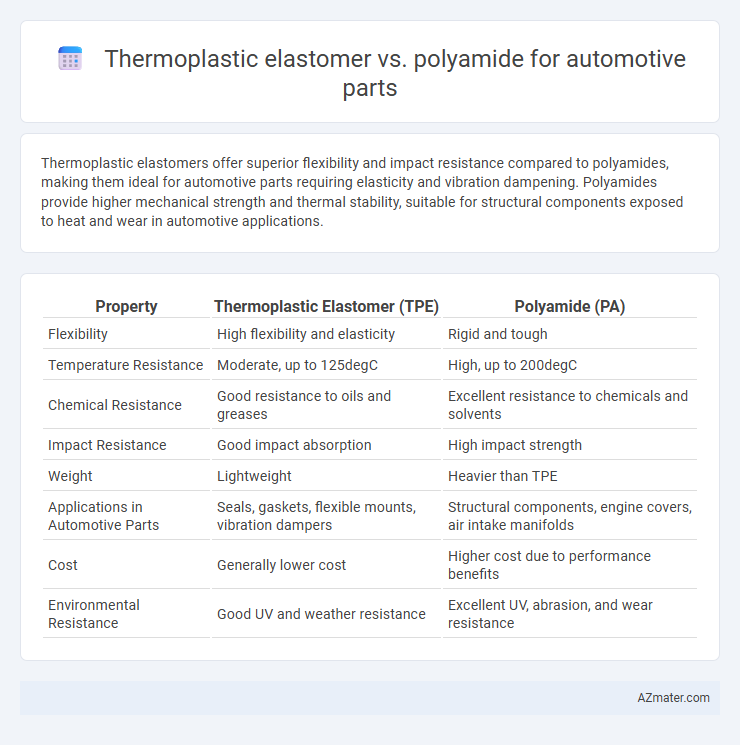Thermoplastic elastomers offer superior flexibility and impact resistance compared to polyamides, making them ideal for automotive parts requiring elasticity and vibration dampening. Polyamides provide higher mechanical strength and thermal stability, suitable for structural components exposed to heat and wear in automotive applications.
Table of Comparison
| Property | Thermoplastic Elastomer (TPE) | Polyamide (PA) |
|---|---|---|
| Flexibility | High flexibility and elasticity | Rigid and tough |
| Temperature Resistance | Moderate, up to 125degC | High, up to 200degC |
| Chemical Resistance | Good resistance to oils and greases | Excellent resistance to chemicals and solvents |
| Impact Resistance | Good impact absorption | High impact strength |
| Weight | Lightweight | Heavier than TPE |
| Applications in Automotive Parts | Seals, gaskets, flexible mounts, vibration dampers | Structural components, engine covers, air intake manifolds |
| Cost | Generally lower cost | Higher cost due to performance benefits |
| Environmental Resistance | Good UV and weather resistance | Excellent UV, abrasion, and wear resistance |
Introduction to Thermoplastic Elastomer and Polyamide in Automotive Applications
Thermoplastic elastomers (TPEs) combine the flexibility of rubber with the processability of plastics, making them ideal for automotive parts requiring vibration damping, weather resistance, and impact absorption. Polyamides (nylons) offer high mechanical strength, thermal stability, and chemical resistance, suitable for structural components and under-the-hood applications in vehicles. The choice between TPE and polyamide depends on specific performance needs such as elasticity, durability, and environmental exposure in automotive design.
Key Properties of Thermoplastic Elastomers
Thermoplastic elastomers (TPEs) exhibit excellent flexibility, high abrasion resistance, and superior impact strength, making them ideal for automotive parts requiring durable, lightweight, and vibration-dampening materials. Unlike polyamides, TPEs offer easier processability with lower molding temperatures and enhanced chemical resistance against oils and fuels. Their ability to combine elastomeric properties with thermoplastic processing advantages leads to cost-effective production and improved recyclability in automotive applications.
Essential Characteristics of Polyamides
Polyamides exhibit high mechanical strength, excellent wear resistance, and superior thermal stability, making them ideal for demanding automotive parts exposed to heat and friction. Their inherent chemical resistance and low moisture absorption contribute to durable performance in harsh environments. Compared to thermoplastic elastomers, polyamides provide rigid support and structural integrity essential for load-bearing automotive components.
Mechanical Performance Comparison
Thermoplastic elastomers (TPEs) offer superior flexibility and impact resistance compared to polyamides, making them ideal for components requiring high elasticity and vibration damping. Polyamides, such as nylon, demonstrate greater tensile strength, stiffness, and thermal stability, which suit them for load-bearing automotive parts exposed to high temperatures. The mechanical performance comparison reveals that TPEs excel in elongation and fatigue resistance, while polyamides provide enhanced durability under mechanical stress and abrasion.
Chemical and Thermal Resistance Differences
Thermoplastic elastomers (TPEs) exhibit superior chemical resistance to oils, greases, and fuels commonly encountered in automotive environments, whereas polyamides (nylons) tend to absorb moisture, which can reduce their chemical stability. In terms of thermal resistance, polyamides generally withstand higher continuous operating temperatures, often up to 120-150degC, while TPEs typically perform well in lower temperature ranges around 80-120degC depending on the specific grade. The choice between TPE and polyamide for automotive parts depends heavily on the required balance between flexibility, chemical exposure, and thermal endurance.
Processing Techniques and Manufacturing Efficiency
Thermoplastic elastomers (TPE) offer superior processing flexibility with faster cycle times in injection molding compared to polyamide (PA), enabling more efficient mass production of automotive parts. Polyamide requires higher processing temperatures and longer cooling times, which can reduce throughput and increase energy consumption on the manufacturing line. Utilizing TPEs often results in lower tooling wear and easier recyclability, contributing to improved overall manufacturing efficiency for automotive applications.
Cost Analysis: Thermoplastic Elastomer vs Polyamide
Thermoplastic elastomers (TPEs) generally offer lower material and processing costs compared to polyamides (nylons) in automotive part manufacturing due to their simpler molding processes and reduced energy consumption. Polyamides provide superior mechanical strength and thermal resistance but often involve higher raw material expenses and more complex processing equipment, increasing overall production costs. Cost analysis reveals TPEs are more economical for flexible, lightweight components, while polyamides are preferred in applications demanding durability, justifying their higher investment.
Sustainability and Environmental Impact
Thermoplastic elastomers (TPEs) in automotive parts offer superior recyclability and lower carbon footprints compared to polyamides, which are derived from petroleum-based sources with higher energy consumption during production. TPEs enable efficient material recovery and reuse, reducing landfill waste and supporting circular economy goals in the automotive industry. Polyamides, while durable, pose challenges due to their non-biodegradable nature and greater environmental persistence, increasing long-term ecological impact.
Typical Automotive Parts Using Each Material
Thermoplastic elastomers (TPE) are commonly used in automotive parts requiring flexibility and vibration damping, such as seals, gaskets, and dashboard components. Polyamide (PA), known for its strength and thermal resistance, is typically found in under-the-hood components, fuel system parts, and structural elements like radiator end tanks and air intake manifolds. Selecting between TPE and PA depends on the specific performance requirements, including flexibility, mechanical strength, and temperature resistance in automotive applications.
Conclusion: Material Selection Guidelines for Automotive Parts
Thermoplastic elastomers (TPE) offer superior flexibility, impact resistance, and ease of molding, making them ideal for automotive parts requiring vibration dampening and high elasticity. Polyamide (PA), or nylon, provides excellent mechanical strength, thermal stability, and chemical resistance, suitable for structural components exposed to high stress and temperatures. Selecting between TPE and polyamide depends on the specific application demands, balancing flexibility versus durability, lightweight properties versus high load-bearing capacity, and environmental exposure factors to optimize part performance and longevity in automotive design.

Infographic: Thermoplastic elastomer vs Polyamide for Automotive part
 azmater.com
azmater.com